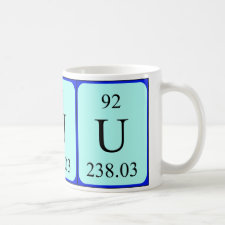
Authors: Liu YC, Zhang XW, Liu HJ, Xu WJ
Article Title: Synthesis of uranyl sulphate imprinted ion exchange resin and its recognition characteristics.
Publication date: 2006
Journal: Journal of Chemical Engineering of Chinese Universities
Volume: 20
Issue: (4)
Page numbers: 510-514.
Alternative URL: http://en.cnki.com.cn/Article_en/CJFDTotal-GXHX200604002.htm
Abstract: In order to concentrate uranium from its dilute solution, the uranyl sulphate imprinted ion exchange resins were synthesized in water by using self-assembling imprinting technology, during which, the uranyl sulphate was used as template and the diethyl allylamine as functional monomer. The performances of prepared imprinted resins, such as the pH influence on adsorption capacity, the isothermal adsorption and adsorption dynamics, the adsorption and elution curves of the molecular imprinting polymer MIPs-4 in the ion exchange resin column, were studied and the synthetic conditions of imprinted resins were optimized. Experimental results show that the imprinted resins have better recognition characteristics than that of un-imprinted resins and can be used in a wider pH range of 1 to 6, while its adsorptive ability is the highest when pH = 2. Among the imprinted resins synthesized, the MIPs-4 is the best, its adsorption isotherm is classy, its adsorption equilibrium can be reached after 3h, and when the uranium concentration of the original solution is 0.125 mg mL-1, its distribution coefficient is 0.249 L g-1. The experiments of adsorption in column show, when 1.0 mg mL-1 uranium aqua is served as influent and the contact time is 4 min, the breakthrough volume of the MIPs-4 resin is 22 times the bed volume of the resin (BV), and the breakthrough capacity and saturated capacity are 21.6 mg mL-1 and 36.2 mg mL-1, respectively. When 0.05 mol L-1 H2SO4 + 1.0 mol L-1 NaCl is used as effluent, the elution volume is only about 4.0 BV and the maximum uranium concentration of effluent reaches 17.6 mg mL-1. Since the MIPs-4 resin has good adsorption and elution properties, it is suitable to be used to concentrate the dilute uranium aqua and to dispose the wastewater containing uranium
Template and target information: uranyl sulphate
Author keywords: Diethyl allylamine, ion exchange resin, Molecular imprinting technology (MIT), Uranyl sulphate ions



Join the Society for Molecular Imprinting

New items RSS feed
Sign-up for e-mail updates:
Choose between receiving an occasional newsletter or more frequent e-mail alerts.
Click here to go to the sign-up page.
Is your name elemental or peptidic? Enter your name and find out by clicking either of the buttons below!
Other products you may like:
 MIPdatabase
MIPdatabase









